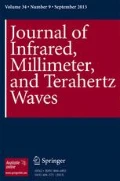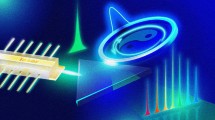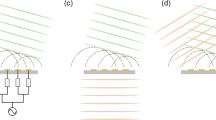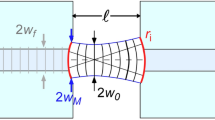Abstract
We analyse the use of a tunable dual wavelength Y-branch DBR laser diode for THz applications. The laser generates electrically tunable THz difference frequencies in the range between 100 and 300 GHz. The optical beats are tuned via current injection into a micro-resistor heater integrated on top of one of the distributed Bragg reflector (DBR) section of the diode. The laser is integrated in a homodyne THz system employing fiber coupled ion-implanted LT-GaAs log spiral antennas. The applicability of the developed system in THz spectroscopy is demonstrated by evaluating the spectral resonances of a THz filter as well as in THz metrology in thickness determination of a polyethylene sample.
Similar content being viewed by others
1 Introduction
Dual wavelength diode lasers in the visible and near infrared spectral ranges have been used for various applications. Whereas the shorter wavelength devices between 650 and 850 nm were used, e.g., for Raman spectroscopy, especially shifted excitation Raman difference spectroscopy, longer wavelength devices in the spectral range between 1300 and 1550nm have become key components for compact and efficient CW THz systems [1,2,3,4]. Such monolithic two-color diode lasers are becoming increasingly attractive in comparison to conventional THz systems with two independent diode lasers mainly due to their simplified setup, compactness, simplified spatial overlaps of the two modes, affordability, and highly stable optical beat frequency [1,2,3,4]. Generally, compact homodyne CW THz systems are attractive for real-time THz applications. Simple and cost-efficient systems for thickness measurements and spectroscopic application have already been demonstrated based on two colour distributed feedback (DFB) diode lasers operating in the optical communication windows of 1300 nm and 1550 nm [5,6,7,8,9,10]. Such systems allow for a real-time operation employing frequency scanning either with or without a delay stage [5, 6]. Moreover, frequency modulation of the CW THz signal opens the possibility to eliminate the mechanical delay line in the homodyne system which reduces its complexity [7, 8]. In this work, we analyse the suitability of an electrically tunable two color distributed Bragg reflector (DBR) diode laser at 785-nm centre wavelength for THz applications. The diode laser was successfully developed for the abovementioned Raman spectroscopic applications [11, 12] where the two wavelengths were used alternatingly. In contrast, in this work, the laser operates at both wavelengths simultaneously in order to generate THz radiation. Previously, we published the generation of single frequency THz radiation at 300 GHz with a non-tunable two-colour laser [13, 14]. In this work, we introduce a tunable two-colour DBR laser and study the tuning behaviour of the THz system at difference frequencies between 100 and 300 GHz by implementing the laser into a standard homodyne THz setup. We perform proof-of-principle application studies in THz spectroscopy and metrology. The use of such a shorter wavelength laser offers the opportunity to realise a multisensor system employing, for example, Raman and THz spectroscopy, simultaneously with one diode laser light source.
1.1 Device Description and Setup
The system utilises an electrically tunable monolithic two-color DBR-RW-diode laser to excite a log spiral ion implanted LT-GaAs photoconductive antenna for continuous wave THz generation via photomixing. The diode is a distributed Bragg reflector (DBR) device which simultaneously emits at two wavelengths around 785 nm. A scheme of the device is shown in Fig. 1. The device is based on a vertical layer structure grown by metalorganic vapour-phase epitaxy as described in Ref. [15]. The device length is 3 mm and the width of the ridge waveguide amounts to 2.2 μm. The DBR-grating was manufactured as 10th order deeply etched surface grating having a length of 500 μm. The DBR grating for λ1 has a 0.6-nm smaller wavelength compared to the λ2 DBR grating. Above the grating for λ1, a resistor heater is implemented, which was operated with a current Iheater to tune the grating wavelength towards longer wavelengths, i.e., to reduce the spectral distance between the two branches. For the Y-branch, an S-bend design was selected with a curved waveguide having a length of 2000 μm. To operate the RW-branches individually, a 1350-μm long contact was processed above these sections, followed by a 200-μm contact over the coupler. A 450 μm of the S-bend and a 500-μm long straight RW were used to form a 950-μm output section.
1.2 Electro-Optic Properties
Figure 2 shows the power-voltage-current characteristics for the diode laser at a temperature T = 20 °C and at an output section current of Ioutput = 35 mA. From Fig. 2, it can be seen, that laser operation starts at an injection current of IRW − las = 40 mA. The output power increases with a slope efficiency S = 0.62 W/A. At IRW = 400 mW, an output power of P = 200 mW was measured. The conversion efficiency is ηc≈ 0.3. A micro-resistor heater implemented on top of the DBR section enables variation of the spectral separation between the two wavelengths. This can be seen in Fig. 3. At an injection current IRW = 200 mA, i.e., an output power of about P = 100 mW, the heater current was varied between 0 and 350 mA leading to a reduction of the wavelength spacing from ∆λ = 0.6 nm (290 GHz) at Iheater = 0 mA down to nearly ∆λ = 0.2 nm at Iheater = 230 mA. In this current range, the wavelength λ1 tunes from 784.4 to 784.9 nm and λ2 from 785.0 to 785.1 nm. The emission exhibits multiple modes around the two main wavelengths λ1 and λ2 with mode hops appearing at certain operation points. Their mode spacing according to the resonator length of the device is about 30 pm (15 GHz).
For the measurements, the monolithic chip was mounted p-side up on a copper conduction cooled package (CCP) with 25 mm by 25 mm footprint. In the THz-set-up, the CCP was mounted on an Aluminum heat sink which was thermally stabilised with a Peltier element, and a 10 kΩ thermistor was used for completing the thermoelectric loop. The collimated beam from the diode was coupled into a polarisation maintaining single mode fiber for spectral analysis. For THz measurements, a coherent homodyne scheme was employed to generate and detect the emitted THz radiation as described in more detail in our previous work [13, 14]. The THz emitter and receiver photomixer chips are fiber-coupled ion-implanted gallium arsenide (GaAs) self-complimentary logarithmic spiral photoconductive antennas with interdigitated finger electrodes manufactured by defect engineering technology on GaAs substrate [16]. The output of the two-color laser was split into two parts (emitting arm and detecting arm), with the detecting arm containing a mechanical delay stage which was varied over time to enable both the phase and amplitude information to be obtained. To enhance the detection of THz radiation at the receiver, we incorporated THz lenses (TPX and Teflon) such that maximum THz radiation intensity was focused at the receiver.
1.3 Tunable CW Terahertz Generation
The THz field generated at the emitting antenna was measured at the receiving antenna as a photocurrent with lock-in amplifier while the heater current Iheater was increased from 0 to 200 mA. The bias voltage at the emitter antenna was modulated to enable lock-in measurement. The frequency spectra shown in Fig. 4 were obtained by fast Fourier transform (FFT) of the generated photocurrent signal transients, measured with a mechanical delay stage with a delay time of 320 ps. The resulting THz frequency values correlate well with the measured optical beat frequency signal shown in Fig. 3. These measurements verify the tunability of the THz signal from 0.18 to 0.3 THz. The spectrum at a heater current of 0 mA (Fig. 4 top) shows distinct frequencies at 0.271 THz, 0.288 THz, 0.300 THz, and 0.316 THz with the expected spectral mode spacing of about 15 GHz due to the splitting of the two-color bands of the laser into multiple modes.
THz spectra obtained from FFT of photocurrent measurements, showing tunable multifrequency emission in the range 0.182 to 0.3 THz.
1.4 Potential Applications
Though the spectral properties of the laser are not yet optimised for pure single mode emission at the two wavelength bands and for continuous tuning, we analyse its potential for simple applications in THz spectroscopy and THz metrology. As an example for THz spectroscopy, a THz bandpass filter (BPF250GHz-24 Tydex) designed for maximum transmission at 250 GHz was investigated on its resonance features. The measurements were done by introducing the filter in the path of the THz signal, in between the transmitting and receiving antennas. The THz transmission of the filter was determined by measuring the THz signal as a function of frequency with and without the filter in the path of the THz beam. The obtained normalised THz transmission spectrum is shown in Fig. 5 in comparison to the normalised reference spectrum provided by the manufacturer. Our measurement results are in good agreement with the given transmission characteristics and thus demonstrate that our system can be used for simple spectroscopic measurements.
To demonstrate the potential applicability of the developed system in THz metrology, a 3.1-mm polyethylene block sample was prepared and analysed to determine its thickness. We tuned the beat frequencies transmitted through the sample by adjusting the heater current of the diode in the range between 0 to 350 mA. A multi-frequency THz map of the different THz frequency signals was obtained to determine the thickness of the sample directly from the position shift of the modes due to the delay introduced by the sample with respect to the original mode position as shown in Fig. 6. The measurement was performed in the frequency range between 100 and 315 GHz. By performing THz measurements with and without the sample and measuring the induced shift of the position of the different THz frequency modes in comparison to the position within the reference measurement, we extract the values for the optical thickness which are depicted in Fig. 7. We obtain an average position shift of 1.4 mm. The actual thickness of the sample can be calculated from the known refractive index (n) of the material. Using n = 1.54 from [17, 18] and using the equation ∆l = (n − 1)ds where ∆l is the optical thickness and ds is the sample thickness, we obtain ds = 2.6 mm. This is in reasonable agreement with the thickness of 3.1 mm obtained by a Vernier caliper but suggests that the refractive index in our sample at 300 GHz is slightly lower than the value given in [18].
Positions of the maximum intensity plotted against heater currents for the reference position and corresponding new position measurements with the sample at the same heater currents. The difference between the reference position and the new position due to the shift introduced by the sample gives the thickness of the sample
2 Conclusion
We demonstrate a compact electrically tunable CW terahertz system, based on a tunable two-color monolithic DBR diode laser that was originally developed for Raman spectroscopy. The diode laser enables to adjust the optical beat frequency of the emitted wavelengths via current injection to a micro resistor heater implemented on top of the DBR section. CW terahertz generation in the frequency range of 100–300 GHz was demonstrated and used for simple spectroscopic and metrologic applications. For the next device generation, we will modify the diode laser architecture to suppress multimode emission and mode hopping, and to achieve higher difference frequencies. Thus, the device will enable continuous tuning of the THz frequency and enable frequency modulated continuous wave (FMCW) approaches [19] for thickness and depth measurements without mechanically scanning a delay line. Such a laser will be highly attractive as a single light source for multi-purpose systems, including simultaneous Raman and THz sensing.
References
M. Uemukai and T.Suhara, Integrated two-wavelength DBR lasers for tunable photomixing THz-wave generation. European Conference of Integrated Optics, Barcelona, Spain, April.18–20,(2012)
N. Kim, S. Han, H. Ko, Y.A. Leem ,H. Ryu, C.W. Lee, D. Lee, M.Y. Jeon, S. K. Noh, and K.H. Park, Tunable continuous-wave terahertz generation/detection with compact 1.55 μm detuned dual-mode laser diode and InGaAs based photomixer, Opt. Express 19(16),pp.15399,(2011).
B. Sartorius, M. Schlak, D. Stanze, H. Roehle, H. Künzel, D. Schmidt, H.-G. Bach, R. Kunkel, and M. Schell, Continuous wave terahertz systems exploiting 1.5 μm telecom technologies, Opt. Express 17, no. 17, pp. 15002 (2009).
M. Sun, S. Tan, S. Liu, F. Guo, D. Lu, R. Zhang, Q. Kan and C. Ji, Monolithically integrated two-wavelength distributed Bragg reflector laser for terahertz generation, Stu3G.4 ,OSA (2016).
H-C. Ryu, N. Kim, S-P. Han, H. Ko, J-W. Park, K. Moon, and K. H. Park, Simple and cost-effective thickness measurement terahertz system based on a compact 1.55 μm λ/4 phase-shifted dual-mode laser, Opt. Express 20, (23), pp. 25990–25999,(2012).
I-M. Lee, N. Kim, E. S. Lee, S-P. Han, K. Moon, and K. H. Park, Frequency modulation based continuous-wave terahertz homodyne system, Opt. Express 23, (2) p. 846–858 (2015).
M. Theurer, T. Göbel, D. Stanze, U. Troppenz, F. Soares, N.Grote, and M. Schell, Photonic-integrated circuit for continuous-wave THz generation, Opt. Lett. 38, (19) pp. 3724–3726 (2013).
B. Sumpf, M. Maiwald, A. Müller, J. Fricke, P. Ressel, F. Bugge, G. Erbert and G. Tränkle, Comparison of two concepts for dual wavelength DBR ridge waveguide diode lasers at 785 nm suitable for shifted excitation Raman difference spectroscopy, Appl. Phys. B 120, no. 2, pp. 261–269 (2015).
L. Liebermeister, S. Nellen, R. kohlhaas, S. Breuer, M. Schell, and B. Globisch, Ultra-fast, high-bandwidth coherent cw THz spectrometer for non-destructive testing, J. Infrared Millimeter and Terahertz Waves 40, 288 (2019)
A.D.J.F. Olvera, H. Lu, A.C. Gossard, and S. Preu, Continuous-wave 1550 nm operated terahertz system using ErAs:In(Al) GaAs photoconductors with 52 dB dynamic range at 1 THz, Opt. Expr. 25, 29492 (2017)
M. Maiwald, B. Eppich, J. Fricke, A. Ginolas, F. Bugge, B. Sumpf, G. Erbert, and G. Tränkle, Dual-wavelength Y-branch distributed Bragg Reflector Diode Laser at 785 nanometers for shifted excitation Raman difference spectroscopy, Appl. Spectrosc. 68, no. 8, pp. 838–843 (2014).
M. Maiwald, B. Sumpf, and G. Tränkle, Rapid and adjustable shifted excitation Raman difference spectroscopy using a dual-wavelength diode laser at 785 nm, J. Raman Spectrosc. 49, no. 11, pp. 1765–1775 (2018).
J.O. Gwaro, C. Brenner, B. Sumpf, A. Klehr, J. Fricke, and M. R. Hofmann, Compact continuous wave THz source based on monolithic two color laser diode, Proc. SPIE 10684, Nonlinear Optics and its Applications 2018, 106841Y (14 May 2018).
J.O. Gwaro, C. Brenner, B. Sumpf, A. Klehr, J. Fricke, and M.R. Hofmann, Terahertz frequency generation with monolithically integrated dual wavelength Distributed Bragg Reflector semiconductor laser diode, IET optoelectronics special issue 11 (2), pp.49–52,(2017).
G. Erbert, F. Bugge, A. Knauer, J. Sebastian, A. Thies, H. Wenzel, M. Weyers, and G. Tränkle, High-power tensile-strained GaAsP-AlGaAs quantum-well lasers emitting between 715 and 790 nm. IEEE J. Sel. Top. Quantum Electron 5, pp.780–784 (1999).
I. C. Mayorga, E. A. Michael, A. Schmitz, P. van der Wal, R. Güsten, K. Maier, and A. Dewald, Terahertz photomixing in high energy oxygen- and nitrogen-ion-implanted GaAs, Appl. Phys. Lett 91, 031107, pp.1107–1109,(2007).
N. Palka, S. Krimi, F. Ospald, D. Miedzinska, R. Gieleta, M. Malek and R. Beigang, Precise determination of thickness of multilayer polyethylene composite materials by terahertz time-domain spectroscopy, J Infrared Millimeter and Terahertz waves 36, pp.578–596,(2015).
Y-S Jin,G-J. Kim and S-G. Jeon, Terahertz dielectric properties of Polymers, J. of the Korean Physic.Soc. 49(2),513–517 (2006).
N. S. Schreiner, B. Baccouche, W. Sauer-Greff, R. Urbansky and F. Friederich, High-Resolution FMCW Millimeter-Wave and Terahertz Thickness Measurements, European Radar Conference (EURAD),(2017).
Acknowledgments
The work described in this paper has been supported financially by the German Research Foundation (DFG) through TRR 196 (Project-ID 287022738) and the Mercator Research Centre Ruhr. J.O. Gwaro thanks DAAD and Kenyan government for financial support towards his PhD studies.
Funding
Open Access funding provided by Projekt DEAL.
Author information
Authors and Affiliations
Corresponding author
Ethics declarations
Conflict of Interest
The authors declare that they have no conflict of interest.
Additional information
Publisher’s Note
Springer Nature remains neutral with regard to jurisdictional claims in published maps and institutional affiliations.
Rights and permissions
Open Access This article is licensed under a Creative Commons Attribution 4.0 International License, which permits use, sharing, adaptation, distribution and reproduction in any medium or format, as long as you give appropriate credit to the original author(s) and the source, provide a link to the Creative Commons licence, and indicate if changes were made. The images or other third party material in this article are included in the article's Creative Commons licence, unless indicated otherwise in a credit line to the material. If material is not included in the article's Creative Commons licence and your intended use is not permitted by statutory regulation or exceeds the permitted use, you will need to obtain permission directly from the copyright holder. To view a copy of this licence, visit http://creativecommons.org/licenses/by/4.0/.
About this article
Cite this article
Gwaro, J.O., Brenner, C., Theurer, L.S. et al. Continuous Wave THz System Based on an Electrically Tunable Monolithic Dual Wavelength Y-Branch DBR Diode Laser. J Infrared Milli Terahz Waves 41, 568–575 (2020). https://doi.org/10.1007/s10762-020-00676-4
Received:
Accepted:
Published:
Issue Date:
DOI: https://doi.org/10.1007/s10762-020-00676-4











